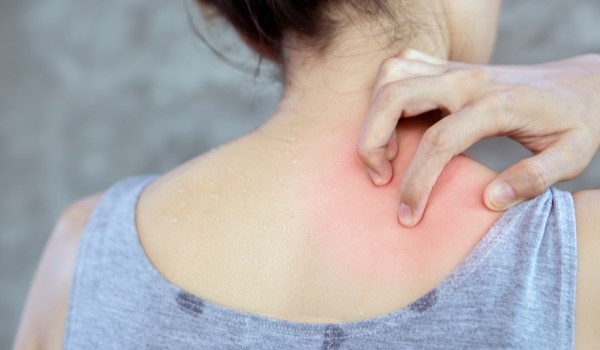What is a
Cholinergic urticaria/sweating urticaria?
Cholinergic urticaria, also known as sweating urticaria or hives, is a rare skin disease that causes itchy, raised skin rashes. It occurs due to a hypersensitivity reaction of the body to physical exertion, sweating, heat or emotional stress. Typically, symptoms occur within a few minutes of exposure and may be accompanied by burning and redness.
About the symptoms
More information
Important information on cholinergic urticaria (sweating urticaria)
Symptoms and consequences of cholinergic urticaria
- Itchy, raised skin rashes (hives)
- Symptoms appear after physical activity, sweating, heat or emotional stress
- Burning and reddening of the skin
- Unpleasant sensations and irritation due to itching
- Reduction in quality of life due to triggers such as physical activity or heat
- Possible psychological stress due to visible skin reactions
Different forms of urticaria
There are various forms of urticaria, which are differentiated according to the trigger and symptoms. Here are some other forms of urticaria:
- Chronic spontaneous urticaria: Without a real trigger, this form is the most common.
- Cold urticaria: Triggered by cold, leads to itchy skin rashes after exposure to cold.
- Pressure urticaria: Reaction to pressure or friction of the skin, e.g. from tight clothing, leads to skin rashes.
- Dermographism: Appearance of redness and swelling of the skin in response to light pressure or scratching of the skin.
What are the causes of cholinergic urticaria (sweating urticaria)?
Cholinergic urticaria is triggered by an excessive reaction of the body to physical activity, heat or stress. This reaction is probably caused by an increased level of acetylcholine, a messenger substance in the body. When the body reacts to these triggers, histamines are released, which then lead to the typical symptoms, such as itchy, raised skin rashes, also known as hives. Histamines are chemical substances that play an important role in allergic reactions and inflammatory processes. Genetic predisposition and environmental factors can also play a role in the development of this skin disease.
Heat
Heat
Hot showers or baths, hot climate/weather, sauna
Sport
Sport
Sweating during sport, physical exertion
Food
Food
Hot drinks such as coffee or tea, hot spices, alcohol
Psyche
Psyche
Emotional stress, anxiety
Other diseases
Other diseases
Fever, increased temperature
How is cholinergic urticaria diagnosed?
The diagnosis of cholinergic urticaria is usually based on a thorough medical history, in which the doctor asks the patient about the symptoms and possible triggers. As the symptoms of this form of urticaria are triggered by physical activity, heat or stress, information about these triggers is important.
As the diagnosis and treatment of skin conditions can be complex, it is important to see a dermatologist to get an accurate diagnosis and receive appropriate treatment.
Provocation test with the aid of a bicycle ergometer
Provocation test with the help of a hot bath
Possible blood test to rule out other diseases

What to do with cholinergic urticaria (sweating urticaria)
Dealing with cholinergic urticaria demands a lot from you on some days. However, there are a few ways to deal with the disease. It is also important to see a dermatologist for individualized advice and treatment, as each case of cholinergic urticaria can be different.
Avoiding triggers in cholinergic urticaria
Identify and avoid triggers: Pay attention to triggers such as physical activity, heat or stress and try to avoid or reduce them. Also use mild, fragrance-free and hypoallergenic skin care products so as not to irritate the skin further.
Drug treatment of cholinergic urticaria
For a mild form of hives, ointments or creams with cooling menthol can be beneficial. In some cases, the doctor treating hives may also prescribe a cream with a local anesthetic effect. These creams can help to relieve the itching and irritation associated with hives. However, it is important to consult a doctor if symptoms persist or are severe in order to determine the cause of the hives and initiate appropriate treatment.
Cooling and stress management
Wear loose, breathable clothing and use cooling measures such as cold compresses to soothe the skin.
Develop stress management strategies such as relaxation exercises, meditation or yoga to minimize stress triggers.
Sources
Please note that all content provided regarding individual medical conditions, treatments, procedures, etc. is general information and may vary depending on the physician:in and individual case and initial situation.
For more detailed information, please always consult your doctor.
Zuberbier T., Maurer M. Urticaria: current opinions about etiology, diagnosis and therapy. Acta Derm Venereol, 2007, 87(3), 196-20
Commens C.A., Greaves M.W. Tests to establish the diagnosis in cholinergic urticaria. Br J Dermatol, 1978, 98(1), 47-51
Dice J.P. Physical urticaria. Immunol Allergy Clin North Am, 2004, 24(2), 225-46
Zuberbier T, Althaus C, Chantraine-Hess S, Czarnetzki BM. Prevalence of cholinergic urticaria in young adults. J Am Acad Dermatol 31 (6): 978-81, 1994.
Netdoctor
LinkSkin Info Austria
Link